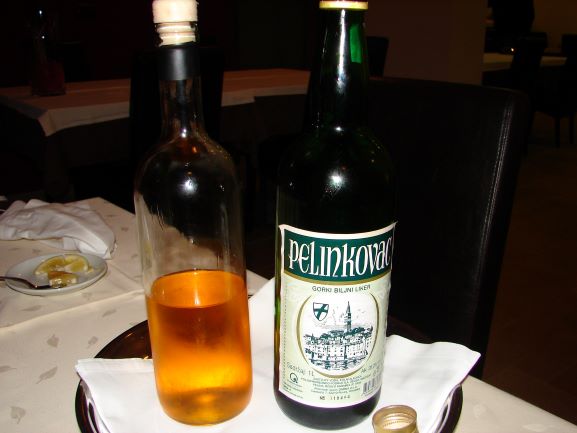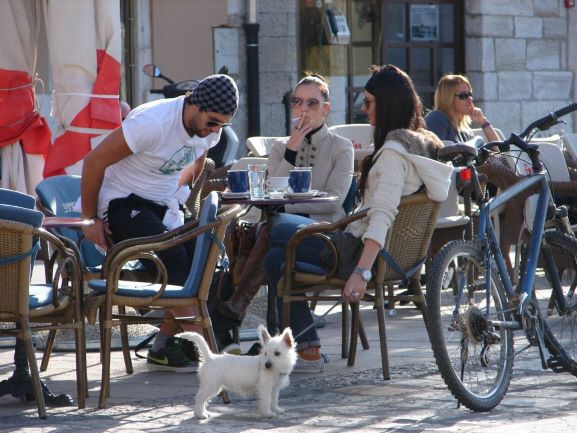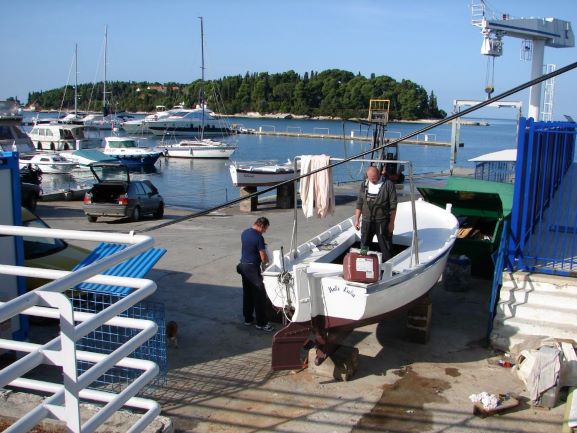Rakija and Floating Saints
While Dubrovnik is getting all the attention in Croatia these days, due in no small part to its prominence in the TV show “Game of Thrones,” Rovinj, on the Istrian coast, is every bit as picturesque while being less crowded and less expensive. Not to mention the better food.
A Short History
Rovinj is on the Croatian coast of Istria along the Adriatic. The area was probably first settled by an Illyrian tribe before being conquered by the Romans. After the fall of the Roman Empire, Rovinj was conquered and reconquered numerous times by several tribes, small empires and feudal lords before coming under the relative stability of the Venetian Empire for over 500 years beginning in 1283. The influence of Venice can be seen in Balbi’s Arch, one of the original gates of the city which has the Lion of Venice carved into the top of the arch.
Originally, Rovinj was an island. But in 1763 a channel was filled in, connecting the island to the mainland.
In the 19th century, Rovinj became part of the Austrian Empire and almost everyone spoke Italian. When Austria fell, Rovinj, or Rovigno as it was called, became part of Italy. After WWII, most of Istria, including Rovinj, became part of Yugoslavia and thousands of Italians were forced out. In fact, Rovinj didn’t regain its pre-WWII population until the 1980’s.
In the early 90’s Croatia declared independence from Yugoslavia and a bloody war broke out. Luckily, Istria was spared from the fighting.
Church of St. Euphemia
As you approach Rovinj, either by land or by water, the first thing you will see is the Church of St. Euphemia, aka Church of Saints George and Euphemia. The church sits in the middle of the island and is built on its highest point.
Euphemia’s life and martyrdom are not well-documented, but legend has it that she was killed in the year 303 after being tortured and thrown to the lions after refusing to disavow her beliefs. Some accounts have the lions licking her torture wounds with Euphemia ultimately being killed by a wild bear in the arena.
Here is where the story gets interesting. Christian churches keep what they call relics in order to bring pilgrims (and the pilgrim’s money) to the church. That’s why you’ll see the bones of this saint or the preserved finger of that saint in churches all over Europe. The remains of the now-sainted Euphemia were kept in Constantinople (now Istanbul). At some point Euphemia’s bones (housed in an ark) ended up in the sea. There is debate if this happened because of persecution by the Iconoclasts or due to a flood.

Either way, the legend is that the saint’s tomb washed up in Rovinj in 800 AD. A young boy and his two cows dragged the box with the bones ashore and up to what was then called the Church of St. George, later renamed in honor of St. Euphemia.
But, it doesn’t end there. St. George’s Church in Istanbul claims that the bones were returned to that city and reside in the church.
No matter where the relics reside, the church is a must visit in Rovinj. An easy path winds up the hill, which is dotted with artists painting the famous church of the spectacular view of the city and sea below.
Inside the church is the sarcophagus supposedly containing Euphemia’s relics. There are also several beautiful paintings including one depicting the martyrdom of Euphemia and another showing the boy and his cows dragging the ark ashore.
The bell tower is modeled after the one in St. Mark’s in Venice (Rovinj was part of the Venetian Empire) and is about 180 feet high. Climb about 200 rickety wooden steps to the top of the bell tower for the best view in Rovinj. The sparkling Adriatic, nearby vineyards, and, on a clear day, the Alps are all visible from here.
Fritule
Euphemia is the patron saint of Rovinj and her feast day is September 16th. On this day the people of Rovinj celebrate by eating mutton with sauerkraut (pass) and fritule, a kind of Croatian donut. Like its Italian cousin the zeppole, fritule are small, fried balls of dough. But, these little treats also add rum and citrus zest to the dough. They are often filled with raisins and topped with sugar. On St. Euphemia Day, they are often served with cherries.
Sunset in Rovinj
Facing west, Rovinj has many prime spots for watching the sunset over the Adriatic. The most famous might be the Valentino, a bar that is featured in many guidebooks. Cushions are strewn on the rocks near the water and you can watch the sun go down while sipping very expensive cocktails served by an often surly waitstaff. Forget how much you’re spending and block out the attitude and enjoy the view. Or, better yet, travel during the off season when the Valentino is closed and scramble onto the rocks for free.
If sitting on a rock isn’t your idea of comfort, try the Monte Carlo Bar for sunset. Drinks are expensive, but look at where you are! Plus the seats are comfy.
There are also boat cruises that will take you out for sunset but the best idea might be to grab a bottle Istrian wine, a couple glasses, make your way down to the waterfront, and find a spot to make your own.
Rakija
Technically, brandy refers to distilled wine. But, in a broader sense, brandy is made from the pomace (the mash left over after juice is extracted) of almost any kind of fruit. In Rovinj, and all over Istria, that brandy is called rakija. Plum rakija is especially popular, but apple, pear, and peach rakija are also consumed. There’re even several kinds of rakija infused with herbs like juniper.

While you will occasionally see commercially produced rakija, much of the rakija consumed in Istria is homemade (and a lot stronger than the commercially made stuff).
In some areas of the Balkan Peninsula, like Serbia, rakija is served with salad before the main meal. But in Istria it is usually served after the meal as a digestive; perhaps a nod to the Italian influence in the area.
In fact, if you dine at a family-run restaurant an unlabeled bottle may appear at your table after the meal. If this happens, invite the owner to your table for a drink and savor the experience.
Restaurants in Rovinj
There are several high end restaurants in Rovinj where you can splurge on an extravagant dining experience. Monte (not to be confused with Monte Carlo Bar) has a Michelin star and prices to match this lofty appraisal.
The Wine Vault is the basement of the Hotel Monte Mulini, but don’t let its location fool you. This is a stylish Michelin recommended eatery.
My novel Truffle Hunt

If you’re looking for a place that won’t bust your wallet, try Ristorante Bosket, a short walk from the old town. This family-run eatery, which doubles as a B&B, has ultra-local food, including produce, wine, and seafood. I loved this restaurant so much that I put a conversation we had with the waitress (with some artistic license taken) in my novel “Truffle Hunt.”
There is no such thing as a “Local Food Movement” in Istria. Just food. Go into a restaurant and ask where the eggplant was sourced, and you’ll get a blank stare.
“From the garden,” or “From my family’s farm,” are the likely answers.
“Is the wine local?”
“From 500 meters. That way,” the waitress will point.
“I’m sorry, I only drink wine from 100 meters.”

Perhaps the most obvious indication of the Italian influence in Rovinj is the glut of pizza places in the city and the large number of people who speak Italian as a first or second language. Like any tourist spot, Rovinj has its share of mediocre pizza joints (and gelato shops, for that matter). But, there are some very good pizza places as well like Pizzeria Da Sergio. Everyone knows about this place, so expect a wait.
Rovinj must have the most cafés in Croatia. And that’s a good thing. Being surrounded by water, practically everywhere you look, there’s a little spot to sit outside and watch the sun sparkle on the Adriatic. Find your favorite, grab a seat and order a coffee and a pastry and watch the world go by.
Wander the Streets and Alleys of Rovinj
The greatest joy in Rovinj might be aimlessly wandering the streets, popping into shops, grabbing a snack, and just seeing where the day leads you. It is practically impossible to get lost since you’re on an island (okay, it’s a peninsula now, but it used to be an island).
At some point you’re sure to bump into the farmers market, held each day at Trg Valdibora in the middle of the old town. Here you can get fresh fruits and vegetables. Look for truffles in the fall. After the produce vendors pack up in the late morning/early afternoon, craft vendors take over. This is a great spot to grab some souvenirs to take home.
For art lovers, Grisia Street is the place to be. Lined with galleries, there’s lots of works on display from jewelry to woodwork to paintings and more. On the second Sunday in August the art spills out into the street for the Grisia Open Air Art Exhibition. Croatian and international artists display their wares for a show that draws people to Rovinj from all over.

Fishing is still incredibly important to Rovinj. Every morning, boats head out of the harbor and work all day before bringing in the catch, much of which is sold to local restaurants. Hanging out by the harbor can be fun and educational as some traditional Batana boats are still in use. These flat bottom boats are ideal for fishing the shallow waters around Rovinj. We also enjoy walking by the shipyards and watching the workers paint and repair their boats. If marine history is of interest, check out the Batana Eco-museum which has a collection of boats but also aims to educate people about the history and importance of the Batana to the local culture. You can even book an evening boat ride on a real Batana through the museum!
Day Trips
Being on the water, there are several nice trips you can take on the Adriatic from Rovinj. During the summer a ferry operates that takes you to Venice in about 3 ½ hours.
Much closer are the islands of Katarina and St. Andrew. A quick ferry ride from Delfin Pier lands in St. Andrew Island (and the connected island of Maškin) where you can hike in the forest or relax on a pebbly beach and go for a swim. There is a dive center on the island and scuba is very popular with visitors. There’s also a hotel on the island with a restaurant, but it is easy to find seclusion on St. Andrew Island if the narrow streets of Rovinj are making you claustrophobic. Similarly, Katarina Island has a single hotel but a nice forest for hiking, rocky beaches and cliffs where daring folks can jump from high above into the sea.
Monkodonja is only 5km from Rovinj, and for history buffs, it’s worth a visit. Built around 2,000 BC, this Bronze Age settlement probably housed about 1,000 people. Monkodonja was only discovered in the 1950’s and excavation and study of the site is still underway. Many of the buildings, such as they are, are labeled. There is no entrance fee and the site is often deserted so you may have it all to yourself. Taking a bike from Rovinj to Monkodonja can be a fun trip, just be sure to bring a map, GPS, water, and sunscreen. In fact, cycling is very popular all over Croatia and there are several good trails and routes for cyclists to enjoy.
Transportation
Pula Airport
The closest airport to Rovinj has service to most major European cities. Taxi service from the airport is available, but shuttles (Brioni Pula and Rovinj Transfers) are cheaper. Uber is also available.
Ližnjan, Valtursko polje 210, 52100, Pula, Croatia
Zagreb Airport aka Franjo Tuđman Airport
More international cities serviced than Pula, including Montreal, Toronto, Moscow, Tel Aviv and Dubai. Renting a car in Zagreb and driving to Rovinj is preferable since the bus requires getting to Zagreb city center and then likely transferring in Rijeka, a trip that can take many hours.
Ul. Rudolfa Fizira 21, 10150, Zagreb, Croatia
Bus
The main bus station is just outside the historic city center.
Trg na lokvi 6, 52210, Rovinj, Croatia
Train
The closest train station is in Kanfanar, 10+ miles from Rovinj. Not convenient.
Rental car
Rovinj is compact and easily walkable, but if you’re planning a trip to the hill towns of Istria, a rental car is recommended.
Ferry
Two companies (Venzia and Adriatic Lines) offer ferry service several times a week to Venice. The trip takes 3-3 ½ hours. There is also ferry service to Dubrovnik and the Italian city of Trieste. Seasonal service.
Local ferries service the nearby islands of Katarina and St. Andrew. Departure point is Delfin Dock Station. Seasonal service.
Local transportation
There is no local public transportation in Rovinj but uber and taxis are widely available.
Index of Things to Do in Rovinj
Church of St. Euphemia
Church that supposedly houses the bones of Saint Euphemia. Climb the bell tower for a beautiful view of the Adriatic.
Garibaldijeva Ulica – Via Garibaldi 1, Rovinj 52210, Croatia
Valentino
Bar with some of the best views for sunset. Very expensive with attitude in spades.
Ulica Svetoga Krizha – Via Santa Croce 28, Rovinj 52210, Croatia
Istria Bike
Interactive website listing bike routes of all difficulty levels in Rovinj and Istria
Batana Eco-museum
Museum dedicated to the history of the Bantana, a local boat important to the culture of Rovinj. You can also book a batana boat excursion here.
Obala Pina Budicina – Riva Pino Budicin 2, Rovinj 52210, Croatia
Grisia Open Air Art Exhibition
Held the second Sunday in August. Outdoor art festival/exhibition/competition with artists from around the world.
Grisia Street, Rovinj, Croatia
Katarina Island and St. Andrew Island
Islands are a short ferry ride from the dock in Rovinj. Excellent spots for hiking, sun bathing, swimming, and scuba diving on both islands.
Monkodonja
Bronze Age settlement 5km from Rovinj. Biking here from the town is a fun trip.
Hill Fort near Rovinj, Rovinj, Croatia
Index of Food & Drink in Rovinj
Monte Carlo Bar
Located right on the water, another excellent sunset spot
Ul.Sv.Kriza 21, Rovinj 52210, Croatia
Monte Restaurant (not to be confused with Monte Carlo Bar)
Michelin starred restaurant featuring a great wine list.
Montalbano 75, Rovinj 52210, Croatia
Wine Vault Restaurant
Stylish restaurant in the basement of the Hotel Monte Mulini.
A.Smareglie bb, Rovinj 52210, Croatia
Ristorante Bosket
Family run restaurant a short walk from the old town featuring local ingredients.
J. Tankovica bb, Rovinj 52210, Croatia
Pizzeria Da Sergio
Excellent pizza in the old town. Very busy in the summer.
Grisia – Grisia 11 | 52210 Rovinj, Rovinj 52210, Croatia
Blu
Fine dining across the water with a beautiful view of old town Rovinj.
Val del Lesso 9, Rovinj 52210, Croatia
Index of Shopping in Rovinj
Grisia Street
Several cool galleries line this street in Rovinj.
Grisia Street, Rovinj, Croatia
Profumo di Rovigno
Perfumes and toiletries with a Rovinj twist.
Carera – Carera 45/47, Rovinj 52210, Croatia
Atelier Sottomuro
Art Gallery, now operated out of the artist’s home.
Index of Places to Stay in Rovinj
Hotel Adriatic
Great location right on the waterfront. Nice, upscale bar.
Obala Pina Budicina 16, 52210 Rovinj, Croatia
Hotel Lone
Modern, stylish with all the amenities and a nearby beach. Short walk to old town.
Luje Adamovica 31, Rovinj 52210, Croatia
Residence Porta Antica
Old town apartments, some with water views, reasonably prices, especially considering the location. No elevator, some apartments have narrow staircase access.
Vrata Pod Zidom – Porta Sotto Muro 1, Rovinj 52210, Croatia
Villa Tuttorotto
Boutique hotel in old town. Balcony for breakfast.
Dvor Massatto 4, Rovinj 52210, Croatia
Apartments Nina
Lovely apartments, just a short walk to the old town.
Ljudevita Gaja 16, 52210 Rovinj, Croatia
Island Hotel Katarina
Hotel on the island of Katarina. Surprisingly reasonable considering the location. Lounge has an incredible view back to Rovinj.
Otok Katarina 1, Rovinj 52210, Croatia
About the Author

Brent Petersen is the Editor-in-Chief of Destination Eat Drink. He currently resides in Setubal, Portugal. Brent has written the novel “Truffle Hunt” (Eckhartz Press) and the short story collection “That Bird.” He’s also written dozens of foodie travel guides to cities around the world on Destination Eat Drink, including in-depth eating and drinking guides to including the Hill Towns of Istria and Ljubljana, Slovenia. Brent’s podcast, also called Destination Eat Drink, is available on all major podcasting platforms and is distributed by the Radio Misfits Podcast Network.
